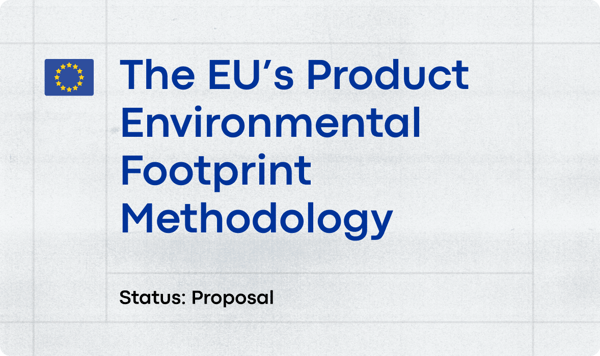Twenty-two percent of global greenhouse gas emissions stem from Forestry, Land and Agricultural (FLAG) activities. It should come as no surprise that the apparel and textile industries play a big role in that figure as raw materials are frequently derived from natural, land-based sources.
FYI: Throughout this article, you’ll see us reference both the Greenhouse Gas Protocol (GHG Protocol) and the SBTi. These two bodies work closely together to ensure alignment in the accounting and target-setting for FLAG emissions. FLAG emissions, as defined by the SBTi, represent a subset of GHG Scope 3 emissions, focusing specifically on land-based emissions sources. For more on the GHG Protocol, read our Carbon Accounting for Fashion Guide.
FLAG emissions in a fashion and apparel company's Scope 3 category, specifically from Purchased Goods & Services, largely originate from the production of natural fibers like cotton, leather, and wool. In fact, for some apparel brands, wool alone can account for up to 50% of their total carbon emissions. That’s why accurately measuring and setting reduction targets from land-based CO2 emissions is essential for fashion brands to lower their climate impact.

The Science Based Targets initiative's (SBTi) FLAG guidance is a new framework that requires companies to measure and set precise reduction targets for their FLAG-related emissions in addition to their energy/industry SBT. For apparel and footwear brands, following this guidance can provide greater visibility into your emissions down to the farm level. In addition to reducing land-based emissions, following the SBTi FLAG guidance enables companies to identify opportunities to restore important carbon sinks such as forests, oceans, and peatlands.
The GHG Protocol provides the foundational guidelines and tools for companies to accurately measure and report their greenhouse gas emissions. In 2023, the organization released a draft Land Sector & Removals (LSR) guidance. SBTi has since mandated that companies use the GHG guidance to set targets.
Curious to deep-dive into the draft? Below is a recording of GHG Protocol Land Sector and Removals Draft Guidance Review Group launch webinar:
Source: https://ghgprotocol.org/land-sector-and-removals-guidance
Key challenges blocking the GHG Protocol guidance
The two issues blocking the completion of the GHG Protocol Land Sector and Removals Standard and Guidance about which the different commitees yet not agreed are:
- Forest Carbon Accounting – GHG emissions and removals from changes in carbon stored in forests and forest products, accounting for both carbon absorbed by forests and carbon released through activities like deforestation or harvesting.
- Agricultural Leakage Quantification (indirect land use change) – No agreed method to measure emissions caused by displaced agricultural activities
However, GHG Protocol Land Sector and Removals Standard Guidance will be published in Q4 2025.
What does the SBTi FLAG mean for apparel and footwear?
SBTi is a corporate climate action organization that helps companies set emissions-reduction targets grounded in climate science, driving climate action towards the goals of the Paris Agreement. The organization has developed a series of standards, tools, and guidance mechanisms, but until recently, their work only covered energy and industry-related GHG emissions. Enter FLAG, expanding the scope from energy-and-industry only.
There are five key requirements of the SBTi FLAG Guidance:
- Set Near-Term FLAG Science-Based Targets: Establish 5-10 year emission reduction targets aligned with the goal of limiting global warming to 1.5°C.
- Account for Removals in Near-Term Targets: Include biogenic CO2 removals, such as restoring natural ecosystems, improving forest management, implementing silvopasture, and enhancing soil carbon sequestration
- Set Long-Term FLAG Science-Based Targets: For companies significantly involved in land and agriculture, long-term targets must reduce emissions by at least 72% by 2050, following the SBTi Net-Zero Standard.
- Zero Deforestation by 2025: Companies must commit to zero deforestation by 2025, in line with the Accountability Framework initiative (AFi).
- Set Science-Based Targets for Fossil Emissions: In addition to FLAG targets, companies must also establish energy/science-based targets for fossil fuel-related emissions. relea
The new FLAG guidance enlarges the scope of their work, enabling fashion and textile brands to include FLAG emissions. As you’ll soon see it’s extremely comprehensive, and at times complex. It demands a lot of data — especially from suppliers — but we’ll take it piece by piece and delve into how your brand can utilize this guidance.
What is covered under the FLAG guidance?
There are three critical emissions-related categories covered under the FLAG guidance that will define how data is collected and later reported upon.

These include:
- Land Use Change (LUC) related emissions: encompasses the greenhouse gasses emitted when natural landscapes are altered for agricultural purposes.
- Example: CO2eq emitted by converting 1 m² of forest (high carbon absorption) to 1 m² of cotton field (low carbon absorption)
This category highlights the environmental impact of transforming natural ecosystems — whether that’s deforestation, forest degradation, or wetland conversion — into agricultural land. The amount of time that has passed since the land was transformed for agricultural purposes will impact the emissions count, which will be discounted linearly over 20 years.
- Land Management (LM) related emissions: addresses the greenhouse gasses generated from ongoing agricultural practices and land management during the raw material stage. This includes emissions from activities such as burning agricultural waste, using fertilizers to grow cotton, using farm machinery, and managing manure.
- Example: direct N2O (Nitrogen dioxide) emissions from soil due to fertilizer application or methane (CH4) emissions from sheep farming
Tip: fossil-based emissions from machinery (e.g., tractors) and energy emissions embedded in fertilizer are not technically "land-based emissions." However, you can choose to include them in your FLAG emissions accounting. Alternatively, they may be included in an energy/industry target, but pay attention not to double-count them across FLAG and energy/industry targets.
- Carbon removal and storage: focuses on capturing and storing CO2 through sustainable land management practices. This includes activities such as soil carbon capture on farm and pasture, agroforestry, and conservation reserves. In the FLAG targets, removals must be reported separately from emissions, and they can’t be used to offset against the energy/industry-related targets. Fashion companies can also not use purchased carbon credits to meet their near-term FLAG or energy/industry targets.The removal must occur on land owned or operated by a supplier or within the fashion brand’s supply chain.
Which textile companies will be impacted by FLAG?
SBTi reporting is not currently mandatory from a regulatory standpoint. However, it does serve as a strong framework for reducing carbon emissions in line with reporting requirements such as the CSRD. Companies submitting new SBTi targets or doing their rebaselining must already submit FLAG SBTs today, using the GHG Protocol FLAG draft guidelines.
If your business has already set SBTs, then you will be required to set a FLAG SBT if 20% or more of your Scope 1, 2, and 3 emissions are derived from FLAG sources. In other words, a large percentage of apparel and footwear brands.
The SBTi recommends that companies with FLAG-related emissions that fall below the 20% threshold nonetheless set a FLAG target. If a company chooses not to set a FLAG target, FLAG-related emissions still must be included in the overall energy/industry (non-FLAG) target boundary.
Small and medium enterprises (SMEs) are exempt if they meet two or more of the following criteria:
- <250 employees,
- revenue <€50 million,
- total assets <€25 million.
How to find out if your company falls within 20%?
Many apparel and footwear brands will find that 20% of their emissions are derived from land-based uses. If you use naturally sourced materials such as wool, viscose, rayon, cotton, or leather, there’s a good chance your company falls in this category.
Below are some anonymous examples from our customers using wool:
- Brand 1: Wool accounts for 9.7% of product weight, which accounts for 50% of their total Scope 3 emissions (CO2eq).
- Brand 2: Wool accounts for 3.6% of weight → Wool accounts for 35% of their total Scope 3 emissions (CO2eq).
- Brand 3: Wool accounts for 4.2% of weight → Wool accounts for 38.2% of CO2eq.
In order to assess your own percentage, you’ll first need detailed insights into your value chain. If you’re already measuring your environmental impact for legislation such as the Corporate Sustainability Reporting Directive, you will already be collecting much of this data. If not, utilizing a sustainability platform to measure product emissions – such as Carbonfact – will provide deep insights into your textile supply chain.
Without the use of Carbonfact, your approach would likely be:
- Collect purchase-order data for your primary products that source FLAG materials (e.g. agriculture-based textiles such as wool or cotton). Focus on the products purchased in large quantities.
- Use the emission factor database to calculate the average percentages of FLAG emissions on your broad product categories (“t-shirts”, “trousers”, “jackets”). (You can find a list of FLAG emission factor data bases here).
- Calculate FLAG emissions for these products manually. This will provide you a first estimate in order of magnitude of your FLAG emissions.
Timeline
The timeline for implementation is in flux, depending on when the final FLAG Guidance by the Greenhouse Gas Protocol is released (you can access the draft here). For now, companies should expect the following:
- Immediate FLAG Target Setting for New and Updated Targets: Companies setting or updating science-based targets, including net-zero targets, must set a FLAG target upon submission or resubmission using the draft GHG Protocol Land Sector and Removals Guidance, with exceptions only for those who booked validation slots before April 30, 2023.
- Six-Month Deadline Post-GHG Protocol Release: Companies with validated science-based targets that need to submit a FLAG target must do so within six months after the final release of the GHG Protocol Land Sector and Removals Guidance, expected in Q1 2025.
- No-Deforestation Commitment by 2025: Regardless of the timing of their FLAG target submission, companies must commit to no-deforestation with a target date no later than December 31, 2025, prioritizing the stopping of deforestation and conversion in their supply chains, given that natural forest conversion accounts for 80% of land use change emissions.
How Do Apparel and Footwear Brands Set FLAG SBTs?
- Calculate your FLAG inventory: Before setting FLAG targets, you should first calculate your corporate FLAG GHG inventory according to the GHG FLAG guidelines. As mentioned above, you need to account for FLAG and industry/energy-related emissions separately.
- Rebaseline: To incorporate FLAG into your established science-based targets, you will need to rebaseline and recalculate your existing emissions.
- Separate Land-Based GHG Emissions: Distinguish between energy and industrial emissions versus land-based emissions.
- Set a New Baseline: Select a baseline year where accurate and detailed FLAG data is accessible.
- Evaluate Your Current Target: Confirm that your existing target aligns with FLAG requirements, which are 95% for Scope 1 and Scope 2 emissions, and 67% for Scope 3 emissions.
- Establish a New Target: One that is compliant with the FLAG guidelines.
Example of a FLAG target:
- Near-term target: Reduce Scope 1 and 3 FLAG GHG emissions by 33% over 7 years starting at your base year. No deforestation across our deforestation-linked commodities, with a target date of 2025.
- Long-term target: Reduce Scope 1 and 3 FLAG GHG emissions by 72% from base year to 2050

Sourcing data for FLAG emissions?
For fashion brands setting FLAG targets, it’s important to adhere to the data-quality guidelines from the GHG Protocol's Land Sector and Removals Guidance.
To calculate land use change (LUC) emissions, textile companies should use the most accurate and representative data available – whether from their own operations, suppliers or established emission factors. For FLAG scope 3 emissions, companies should collect high-quality data from suppliers and value chain partners. If emission factors are used, they should be representative of the commodity and region, and any uncertainty associated with default data should be disclosed.
Companies should use granular, representative data for FLAG-related emissions, disaggregating emissions by commodity and region, and separating land use change emissions from land management emissions. CO2 and non-CO2 emissions from land management should also be reported separately.
Land removals should rely on primary data to be included in a FLAG target.
Why is it Worth Investing in FLAG Now?
The GHG Protocol is still determining how to account for CO₂ emissions and removals from forest land and has yet to resolve agricultural leakage quantification. Since FLAG is built on the GHG Protocol, companies must continue using interim guidance until the GHG Land Sector and Removals Standard and Guidance is published in Q4 2025.
Preparing early minimizes compliance risks and last-minute challenges:
- Data readiness takes time. In some cases, a full year to clean everything upstream. Organizing emissions data now ensures a smooth transition when the final guidance is released.
- Know if FLAG applies to you. Most companies don’t know if FLAG applies to them. With Carbonfact, you would already have clarity on whether you exceed the 20% threshold, allowing you to develop a plan of approach.
- Avoid reporting pressure. If the final guidance maintains a six-month compliance window, it will likely overlap with the reporting season. Adding a new, disaggregated dataset at the last minute could create unnecessary complexity.
Investing in FLAG compliance now ensures smooth reporting when the requirements take effect.
How Can Carbonfact Help?
Carbonfact is designed to collect and make sense of large datasets, providing your company with comprehensive climate reporting tools. As you’ve probably gathered by now, FLAG guidance is data intensive. Here’s how Carbonfact can help:
Calculating your FLAG inventory requires a lot of data. For deforestation alone, we will look at inputs such as location of the project, duration, the vegetation type that will be deforested, and final land use after deforestation. This will translate into a metric identifying the CO2 emitted during the entire phase of the project due to land use change. As you can see, that’s already a lot of information for just one reporting category within the LUC related emissions.
Besides sourcing data, the calculation of FLAG emissions relies highly on performing Life Cycle Assessment (LCA) for all of your products. For example, for a sweater made from wool, you need to extract from the full LCA the emissions linked to the agricultural production (e.g., fertilizer input) and upstream emissions (e.g., production of fertilizers).
This is a time-and-resource intensive project that quickly overwhelms.
How does Carbonfact help
- Consolidate and fill in missing data points.
- Prioritize the primary data collection effort where it matters.
- Help navigate the use of the various secondary data sources/tools available.
- Calculate your product emissions – incl. Separate FLAG emissions – even with incomplete data
- Perform your GHG Carbon Accounting and report to SBTi
- Set near and long-term targets
While our platform does the heavy lifting, we have a whole team of data and climate experts by your side supporting you in building plans and making decisions.
FLAG Webinar
Recently, we hosted a webinar with Dr. Laurent Vandepaer, PhD, Carbonfact's Head of Science. You can find the on-demand recording of the webinar above. Below is a sneak peek of the Q&A session from the discussion:
- How does Carbonfact ensure that company's submitted FLAG emissions are accurate or does this fall outside of Carbonfact's scope?
Carbonfact follows the latest guidance on modeling emissions, ensuring that FLAG emissions are accurately represented according to established standards. - Do you have the possibility to integrate your platform with the request from Fairly Made, Textile Genesis, or other similar platforms?
Yes, we have built integrations with various platforms before. For specific integration needs, please reach out to us directly. - When does reporting begin regardless of target setting? Would it also be within the 6-month period?
Reporting will depend on the finalized guidance. We recommend that companies set up systems early to handle the complexity of supply chain data, which often requires months to a year for cleaning, especially in the apparel and footwear industry. Follow our blog for updates on this. - Which materials are in the scope of FLAG? Are recycled materials included?
FLAG covers biobased materials grown and harvested using agricultural processes. For recycled materials, we generally follow the cutoff approach as outlined in the GHG Protocol, meaning we exclude the upstream emissions of these materials from the FLAG scope. - According to your experience, did you see any impact in terms of emission reduction thanks to the use of certified materials (e.g., RWS)?
Certifications like FSC for deforestation reduction and regenerative agriculture certifications can help lower emissions, particularly in land management and removals. - Most LCA datasets attempt to include raw material emissions data already – usually based on non-land use estimates. When you calculate FLAG using the method you described earlier, are these estimates still included or are they removed?
We remove the FLAG emissions from existing datasets and apply specific FLAG emissions on top. However, some datasets may lack proper documentation, and we do our best to use disaggregated data when available. In some cases, land use change and management emissions can be removed, though limitations exist due to poor documentation and we cannot rule out duplicates. - For companies with limited visibility into raw material production levels in their supply chain, especially several tiers removed, how do they determine land use change (LUC) factors?
In such cases, global averages can be used if specific data isn't available. - Are there any publicly available lists of fashion companies that have set FLAG targets?
There is no official list with companies that have set FLAG targets. However, if you search “FLAG” in SBT Dashboard, you will find quite a few cases.
- When do you have to set FLAG targets?
If your brand has already submitted SBTs, FLAG targets must be set within 6 months of the release of final GHG Protocol guidance, which is expected by Q4 2025.
Sources
- SBTi FLAG Guidance https://sciencebasedtargets.org/resources/files/SBTiFLAGGuidance.pdf
- GHG Protocol FLAG guidance draft https://ghgprotocol.org/land-sector-and-removals-guidance








 Lidia Lüttin
Lidia Lüttin

![[Guide] Carbon accounting for fashion, textile, apparel, and footwear companies](https://www.carbonfact.com/hs-fs/hubfs/CA%20-%20Opt1.png?width=600&name=CA%20-%20Opt1.png)
 Angie Wu
Angie Wu